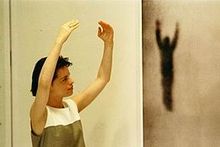Michal Rovner
| Michal Rovner | |
|---|---|
 |
|
| Born | 1957 (age 59–60) Tel Aviv, Israel |
| Nationality | Israeli |
| Education |
Tel Aviv University, Bezalel Academy of Arts and Design |
Michal Rovner (born 1957) is an Israeli video, photo and cinema artist.
Michal Rovner was born in Tel Aviv, Israel. She studied cinema, television, and philosophy at Tel Aviv University and subsequently at the Bezalel Academy of Arts and Design in Jerusalem in 1981, receiving a BFA in photography and art in 1985. In 1978, with artist Arie Hammer, she co-founded the Camera Obscura School of Art in Tel Aviv, the city’s first school for photographers. She moved to New York in 1987.
In her early photography series Outside (1990–91), Rovner photographed a Bedouin encampment in the desert and reprinted it, distorting its size and color. For the Decoy series (1991), she distorted radar and surveillance images to create photographs of indistinct groups of people with blurred features. In One-Person Game Against Nature (1992–93), she again distorted images, this time her own photographs of people floating in the Dead Sea.
In 1996, Rovner began to use film and video, creating works featuring anonymous crowds of people or animals, as in Monoprints of Birds (1998). While she has eschewed direct political commentary in her work, in 1995–96 she produced installations for the Israel-Lebanon border that were situated on electric fences and guard towers in the line of ongoing exchanges of fire. These were complemented by her video Border (1996–97), in which she futilely attempted to demarcate and cross the border from Israel into Lebanon.
Her video Notes (2001) was a collaboration with the composer Philip Glass; Rovner used footage of a group of people walking on an inclined angle, and Glass composed music inspired by this moving image (their collaboration was documented in the 2003 documentary Looking Glass). Time Left (2002), a multichannel-video installation comprising images of endless rows of indistinct beings, was the centerpiece of her mid-career retrospective at the Whitney Museum of American Art in New York in 2002. For the exhibition In Stone, at PaceWildenstein in New York in 2004, she mixed sculpture and video by projecting minute images of crowds onto tablets of stone, blurring the line between image and text.
In the film Fields of Fire (2005), Rovner’s images of oilfields in the Republic of Kazakhstan reflect the persistent instability of a region at the epicenter of international scrutiny. Living Landscape (2005), a site-specific video wall at Yad Vashem in Jerusalem, projects a montage of pre-WWII footage of dances, music, and daily lives of European Jews.
...
Wikipedia
